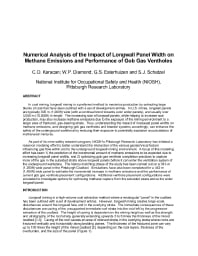Mining Publication: Numerical Analysis of the Impact of Longwall Panel Width on Methane Emissions and Performance of Gob Gas Ventholes
Original creation date: May 2005
Authors: C� Karacan, WP Diamond, GS Esterhuizen, SJ Schatzel
NIOSHTIC2 Number: 20027055
In: Proceedings of the International Coalbed Methane Symposium, May 18-19, 2005, Tuscaloosa, AL: University of Alabama, 2005; :1-28
In coal mining, longwall mining is a preferred method to maximize production by extracting large blocks of coal that have been outlined with a set of development entries. In U.S. mines, longwall panels are typically 1,000 ft wide (with a continual trend toward even wider panels) and usually over 10,000 ft long. The increasing size of longwall panels, while helping to increase coal production, may also increase methane emissions because of the exposure of the mining environment to a larger area of fractured, gas-bearing strata. Thus, understanding the impact of increased panel widths on methane emissions and designing gob gas ventholes and bleeder systems accordingly can enhance the safety of underground workers by reducing their exposure to potentially explosive accumulations of methane/air mixtures. As part of its mine safety research program, NIOSH's Pittsburgh Research Laboratory has initiated a reservoir modeling effort to better understand the interaction of the various geotechnical factors influencing gas flow within and to the underground longwall mining environment. A focus of this modeling effort has been (1) the prediction of the incremental amount of methane emissions to be expected due to increasing longwall panel widths and (2) optimizing gob gas venthole completion practices to capture more of the gas in the subsided strata above longwall panels before it can enter the ventilation system of the underground workplace. The history-matching phase of the study has been carried out on a 1,250-ft-wide panel in the Pittsburgh Coalbed. Simulations have also been completed for a 1,450-ft-wide panel to estimate the incremental increase in methane emissions and the performance of current gob gas venthole placement configurations. Additional venthole placement configurations were simulated to investigation options for optimizing methane capture from the subsided strata above the wider longwall panel.

NIOSHTIC2 Number: 20027055
In: Proceedings of the International Coalbed Methane Symposium, May 18-19, 2005, Tuscaloosa, AL: University of Alabama, 2005; :1-28
- Comparisons Between Cross-Measure Boreholes and Surface Gob Holes
- Degasification System Selection for U.S. Longwall Mines Using an Expert Classification System
- Development of Numerical Models to Investigate Permeability Changes and Gas Emission around Longwall Mining Panel
- Longwall Gob Degasification With Surface Ventilation Boreholes Above the Lower Kittanning Coalbed
- Methane Emission Rate Studies in a Central Pennsylvania Mine
- Modeling and Prediction of Ventilation Methane Emissions of U.S. Longwall Mines Using Supervised Artificial Neural Networks
- A New Methane Control and Prediction Software Suite for Longwall Mines
- Probabilistic Modeling Using Bivariate Normal Distributions for Identification of Flow and Displacement Intervals in Longwall Overburden
- Technology News 448 - Improving the Performance of Longwall Gob Gas Ventholes
- Technology News 465 - Method for Predicting Methane Emissions on Extended Longwall Faces